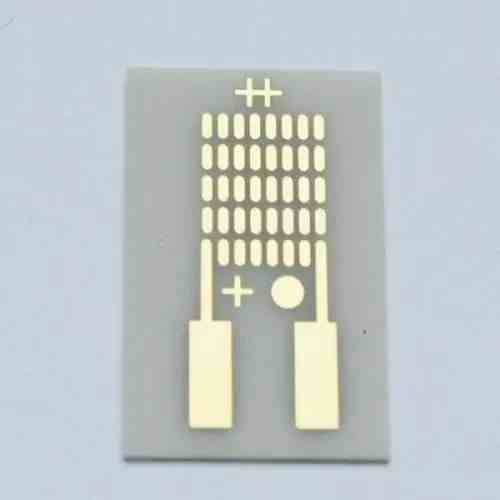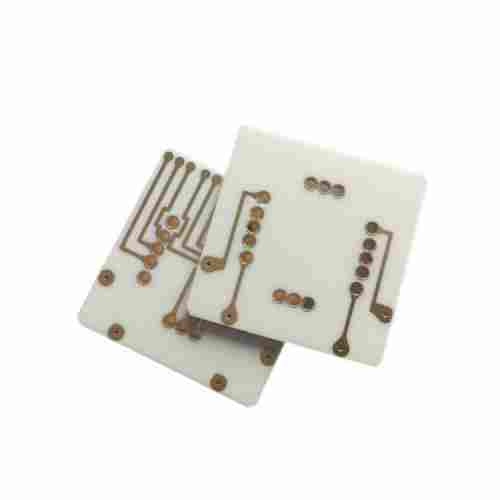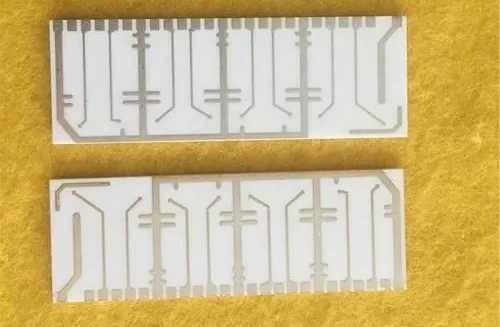Manufacturing the circuit board deals with the utilization of different materials. One well-known material in ceramic PCBs is Aluminum. It’s regarded as the most effective material utilized in a ceramic PCB. Two ceramic materials utilized for ceramic PCBs are Al2O3 (Aluminum oxide) and AlN (Aluminum nitride).
Al2O3 has a higher thermal conductivity compared to the AlN. Moreover, ceramic PCB is a reliable option for different applications. For the purpose of this article, we will be focusing on all the features and properties of Al2O3 PCB.
Describing Al2O3 PCB
Al2O3 PCB can also be called Alumina PCB, which is a printed circuit board made of Al2O3. This ceramic PCB features great properties including great thermal conductivity coupled with a low coefficient of thermal expansion. In addition, Alumina is made up of different isomorphic crystals as well as greater purity. Ceramic PCB has a very important property, which is its great thermal conductivity that falls within the range of 15 to 50W/mk.
Al2O3 PCB is great for use in different applications. Some areas of application include high-frequency devices and LED boards. Furthermore, Al2O3 has ceramic materials designed for the multilayer packages. The printed circuit board has passed through different experiment layers. In addition, it has been able to develop through the years.
Furthermore, Al2O3 can be described as an engineering material which offers great mechanical as well as electrical properties. Also, alumina is the ceramic material that is mostly used. They are also composed of a large quantity of Al2O3. Alumina board’s great thermal stability helps in enhancing the performance and thermal efficiency of circuits utilized in automobiles.
Also, alumina printed circuit boards can possess 75%, 95.5%, and 96% of alumina substrates. When the purity is higher, this means a smoother surface as well as denser appearance. The circuit boards also provide great electrical insulation and have high biocompatibility. Lumina PCB material’s properties contribute to the way it performs.
What Al2O3 PCB Types are There?

Three main alumina oxide types are available. These are 99.5 percent alumina substrate, 96 percent alumina substrate, and 99.6 percent alumina substrate.
99.5 Percent Alumina Substrate
The 99.5 percent alumina substrate is used widely in the smaller applications of the grain size. Also, this PCB surface finish is about 99.5 percent and has the ability to achieve a great finish. You can attribute this to its large size of grain. Furthermore, the materials possess less flexural strength as well as thermal conductivity. One advantage of the substrate is its availability in other larger sizes and thickness.
99.6 Percent Alumina Substrate
The substrate is well known for its thin-film standardized substrates. This is why it contributes to the PCB industry’s popularity. This substrate is great for use in sputtered and evaporated metals. In addition, the substrate has a high level of purity. A smaller grain also exists, which permits it to provide smoother results and less surface defects.
In addition, the substrate features under 1u-in 99.6 percent alumina surface roughness. Therefore, this indicates great electrical insulation, great dielectric properties, as well as a low thermal conductivity
96 percent Alumina PCB Substrate
This type is common. Most microelectronic applications need alumina printed circuit boards. Also, the format required for this application type is thick film substrate. This Al2O3 PCB substrate is utilized for the design of hybrid electronic circuits.
In addition, this substrate works best for the building of hybrid devices. It is due to the high technical availability and quality. In addition, it offers great thermal conductivity as well as a low thermal expansion coefficient.
Manufacturing Process of the Al2O3 PCB
One important material utilized for the fabrication of PCBs is Alumina. In addition, alumina PCB materials have many different properties. Ceramic PCB is made specially to serve ceramic components. In addition, alumina’s properties are different compared to that of other metals. This is why it establishes one major difference when fabricating Al2O3 PCB compared to the others.
Furthermore, Alumina PCB serves some purposes inside the printed circuit board industry. In areas where other oriented circuit boards aren’t applicable, one great option to go for is Alumina. This string and rigid material utilized in Alumina printed circuit boards provides great support for electronic components.
A good substitute to be included when mounting on PCB surfaces is Al2O3. This performance is high in contrast to the other materials. Furthermore, there is higher consistency in temperature which differs from other materials. These materials have just one limitation, which is its high cost compared to other normal materials. Moreover, this happens when you utilize it for several high grade devices.
Also, the alumina PCB does not need any dielectric layer placed in-between the circuit and the core. Usually, PCBs comprising alumina come thicker. The Alumina PCB needs complicated procedures to happen at very high temperatures regardless of the process of manufacturing you adopt.
More on the Manufacturing Process
A ceramic PCB’s manufacturing processes deals with several steps. This direct copper bonding is important during manufacturing. Also, ceramic PCBs provide a strong thermal dielectric. The metal base printed circuit board works with the thick film printing process. The surface finish utilized for the alumina ceramic PCB is very important. One surface finish that is applicable for the aluminum oxide PCB is immersion gold.
Furthermore, during the manufacturing process, a directly plated copper technology can be utilized. In addition, directly plated copper affects the board’s performance.
What are the Properties of the Al2O3 PCB?

Al2O3 PCB is a well-known material for the fabrication of ceramic packages and printed circuit boards. Furthermore, alumina boards provide great electrical as well as mechanical properties. This makes them the preferred option when fabricating the circuit board. Below are the main material properties of the Al2O3 PCB.
Thermal conductivity is low
Al2O3 PCB has a thermal conductivity ranging between 15 and 50 W/mK. Whenever the LED or IC produces extreme heat, this heat will quickly and directly transfer it into the Al2O3 PCB. This is why you don’t need any insulating layer whenever you are making use of the alumina board.
Its melting point is high
The 96% alumina substrate has a melting point of 1400 degrees Celsius. While the 99% type has its melting point values at 1600 degrees Celsius.
Great electrical insulation and hardness
Al2O3 PCBs have great electrical insulation. Because of this great property, the circuit board is very useful in any high-performance application. This reference thickness aids in knowing this PCB’s thickness.
Lower Thermal Expansion Coefficient
Al2O3 PCB has a thermal expansion coefficient that matches its components. In addition, this CTE falls within 6 and 8 ppm per degree Celsius. This is why lower thermal expansion coefficients lead to less stress on the solder joints
What are the Benefits of the Al2O3 PCB?
The ceramic PCBs provide many benefits; however, we will be considering just a few of them.
- It is made up of a strong and rigid material which boosts durability
- Makes sure that the proper mechanical strength is inserted bin ceramic PCBs
- It offers the needed light reflection due to the white material
- Helps in restricting outgassing
- Ceramic PCBs provides great gliding properties as well as low density
- In addition, it works with a high temperature that ranges between 3550 degrees Celsius and 1500 degrees Celsius.
- The size of the package is small. This is because of the integration and possibilities in different multilayer applications.
- In addition, this hermetic packages permits 0 percent absorption of water
- It contributes t corrosion resistance and unmatched wears
- Comes at a fairly low cost
- It provides great performance in the high-frequency applications.
What are the Applications of the Al2O3 PCB?
Al2O3 PCBs are widely used due to their high thermal conductivity, resistance to chemical erosion, low dielectric constant, as well as low thermal expansion coefficient.
Memory module
A Japanese Company created the SRAM memory modules of 1Mbit using multilayer ceramic PCBs having four IC chips. This contributes to the high density assemblies as well as high reliability.
Multilayer interconnect boards
More components are present inside a similar PCB area to ensure the compatibility of ceramic PCB with electronic product miniaturization. This possesses more probabilities for the ceramic PCB in applying multilayer interconnect boards.
Transmission/Receiving Module
This American Company helps in creating transmission/receiving modules for a radar making use of Al2O3 PCB. Furthermore, aluminum nitride features low thermal expansion coefficient and a high thermal conductivity, which creates a great foundation for a ceramic PCB for transmission/receiving module.
Digital/Analog PCB
Also, a Japanese Company used the LTCC PCB in fabricating digital/analog PCBs. This reduces any possible parasitic capacitance by around nine tenths. It will not just get over the circuit tracing’s crosstalk interference, but reduces the circuit’s weight and volume.
Conclusion
In summary, Al2O3 PCB features great properties including great thermal conductivity and low coefficient of thermal expansion. In addition, Alumina is made up of different isomorphic crystals as well as greater purity. Furthermore, Al2O3 PCB is great for use in different applications. Some areas of application include high-frequency devices and LED boards. Also, Al2O3 has ceramic materials designed for the multilayer packages.






Leave a Reply